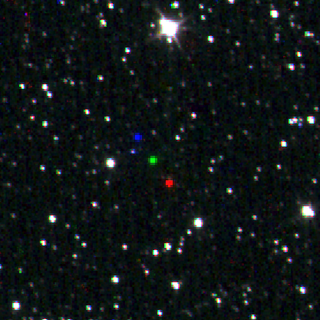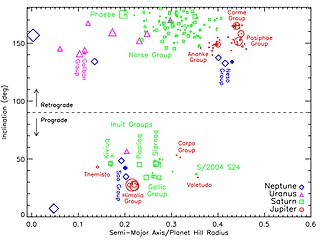Related Research Articles

Siarnaq, also designated Saturn XXIX, is the second-largest irregular moon of Saturn. It was discovered on 23 September 2000 by a team of astronomers led by Brett J. Gladman. It was named after the Inuit goddess of the sea, Siarnaq, who is more commonly known as Sedna. Siarnaq is the largest member of Saturn's Inuit group of prograde irregular moons, which orbit far from Saturn in the same direction as the planet's rotation. The moons of the Inuit group are believed to have originated as fragments from the collisional breakup of a larger progenitor moon after it was gravitationally captured into orbit around Saturn several billion years ago. Several other small Inuit group moons share similar orbits to Siarnaq, indicating that the moon had experienced another collision after forming from its progenitor.

In astronomy, an irregular moon, irregular satellite, or irregular natural satellite is a natural satellite following a distant, inclined, and often highly elliptical and retrograde orbit. They have been captured by their parent planet, unlike regular satellites, which formed in orbit around them. Irregular moons have a stable orbit, unlike temporary satellites which often have similarly irregular orbits but will eventually depart. The term does not refer to shape; Triton, for example, is a round moon but is considered irregular due to its orbit and origins.
S/2020 S 1 is a natural satellite of Saturn. Its discovery was announced by Scott S. Sheppard, David C. Jewitt, Jan Kleyna, Edward Ashton, Brett J. Gladman, Jean-Marc Petit and Mike Alexandersen on May 3, 2023 from observations taken between December 14, 2004 and July 8, 2021.
S/2007 S 5 is a natural satellite of Saturn. Its discovery was announced by Scott S. Sheppard, David C. Jewitt, Jan Kleyna, Edward Ashton, Brett J. Gladman, Jean-Marc Petit and Mike Alexandersen on May 3, 2023 from observations taken between January 5, 2005 and July 9, 2021.
S/2020 S 7 is a natural satellite of Saturn. Its discovery was announced by Edward Ashton, Brett J. Gladman, Jean-Marc Petit and Mike Alexandersen on May 10, 2023 from observations taken between July 1, 2019 and July 24, 2020.
S/2019 S 14 is a natural satellite of Saturn. Its discovery was announced by Edward Ashton and Brett J. Gladman on May 10, 2023 from observations taken between July 1, 2019 and July 9, 2021.
S/2020 S 3 is a natural satellite of Saturn. Its discovery was announced by Edward Ashton, Brett J. Gladman, Jean-Marc Petit and Mike Alexandersen on May 5, 2023 from observations taken between July 3, 2019 and July 9, 2021.
S/2019 S 6 is a natural satellite of Saturn. Its discovery was announced by Edward Ashton and Brett J. Gladman on May 8, 2023 from observations taken between July 3, 2019 and July 8, 2021.
S/2020 S 4 is the faintest natural satellite of Saturn. It was discovered by Edward Ashton, Brett J. Gladman, Jean-Marc Petit and Mike Alexandersen on June 24, 2020, and was announced on May 6, 2023 by the IAU Minor Planet Center after observations were collected over a long period of time to confirm the satellite's orbit that were taken between July 1, 2019 and July 9, 2021.
S/2020 S 5 is a natural satellite of Saturn. Its discovery was announced by Edward Ashton, Brett J. Gladman, Jean-Marc Petit and Mike Alexandersen on May 6, 2023 from observations taken between July 3, 2019 and July 9, 2021.
S/2004 S 43 is a natural satellite of Saturn. Its discovery was announced by Scott S. Sheppard, David C. Jewitt, Jan Kleyna, Edward Ashton, Brett J. Gladman, Jean-Marc Petit and Mike Alexandersen on May 7, 2023 from observations taken between December 12, 2004 and July 9, 2021.
S/2004 S 46 is a natural satellite of Saturn. Its discovery was announced by Scott S. Sheppard, David C. Jewitt, Edward Ashton, Brett J. Gladman, Jean-Marc Petit and Mike Alexandersen on May 8, 2023 from observations taken between December 12, 2004 and July 8, 2021.
S/2019 S 11 is a natural satellite of Saturn. Its discovery was announced by Scott S. Sheppard, David C. Jewitt, Edward Ashton, Brett J. Gladman, Jean-Marc Petit and Mike Alexandersen on May 8, 2023 from observations taken between January 5, 2005 and August 16, 2020.
S/2019 S 13 is a natural satellite of Saturn. Its discovery was announced by Edward Ashton, Brett J. Gladman, Jean-Marc Petit and Mike Alexandersen on May 9, 2023 from observations taken between July 3, 2019 and July 8, 2021.
S/2005 S 5 is a natural satellite of Saturn. Its discovery was announced by Scott S. Sheppard, David C. Jewitt, Jan Kleyna, Edward Ashton, Brett J. Gladman, Jean-Marc Petit and Mike Alexandersen on May 10, 2023 from observations taken between March 9, 2005 and July 24, 2020.
S/2006 S 18 is a natural satellite of Saturn. Its discovery was announced by Scott S. Sheppard, David C. Jewitt, Jan Kleyna, Edward Ashton, Brett J. Gladman, Jean-Marc Petit and Mike Alexandersen on May 15, 2023 from observations taken between December 14, 2004 and July 9, 2021.
S/2019 S 19 is a natural satellite of Saturn. Its discovery was announced by Edward Ashton and Brett J. Gladman on May 15, 2023 from observations taken between July 3, 2019 and July 8, 2021.
S/2006 S 19 is a natural satellite of Saturn. Its discovery was announced by Scott S. Sheppard, David C. Jewitt, Jan Kleyna, Edward Ashton, Brett J. Gladman, Jean-Marc Petit and Mike Alexandersen on May 15, 2023 from observations taken between January 5, 2006 and July 9, 2021.
S/2020 S 9 is a natural satellite of Saturn. Its discovery was announced by Edward Ashton, Brett J. Gladman, Jean-Marc Petit and Mike Alexandersen on May 15, 2023 from observations taken between August 23, 2019 and August 16, 2020.
S/2019 S 21 is a natural satellite of Saturn. Its discovery was announced by Scott S. Sheppard, David C. Jewitt, Jan Kleyna, Edward Ashton, Brett J. Gladman, Jean-Marc Petit and Mike Alexandersen on May 16, 2023 from observations taken between February 2, 2006 and July 8, 2021.
References
- 1 2 3 "Planetary Satellite Mean Elements". Jet Propulsion Laboratory. California Institute of Technology. Retrieved 15 May 2023.
- 1 2 "MPEC 2023-J179 : S/2004 S 52". Minor Planet Electronic Circular. Minor Planet Center. Retrieved 15 May 2023.
- ↑ "S/2004 S 52". Tilmann's Web Site. Tilmann Denk. Retrieved 24 December 2023.